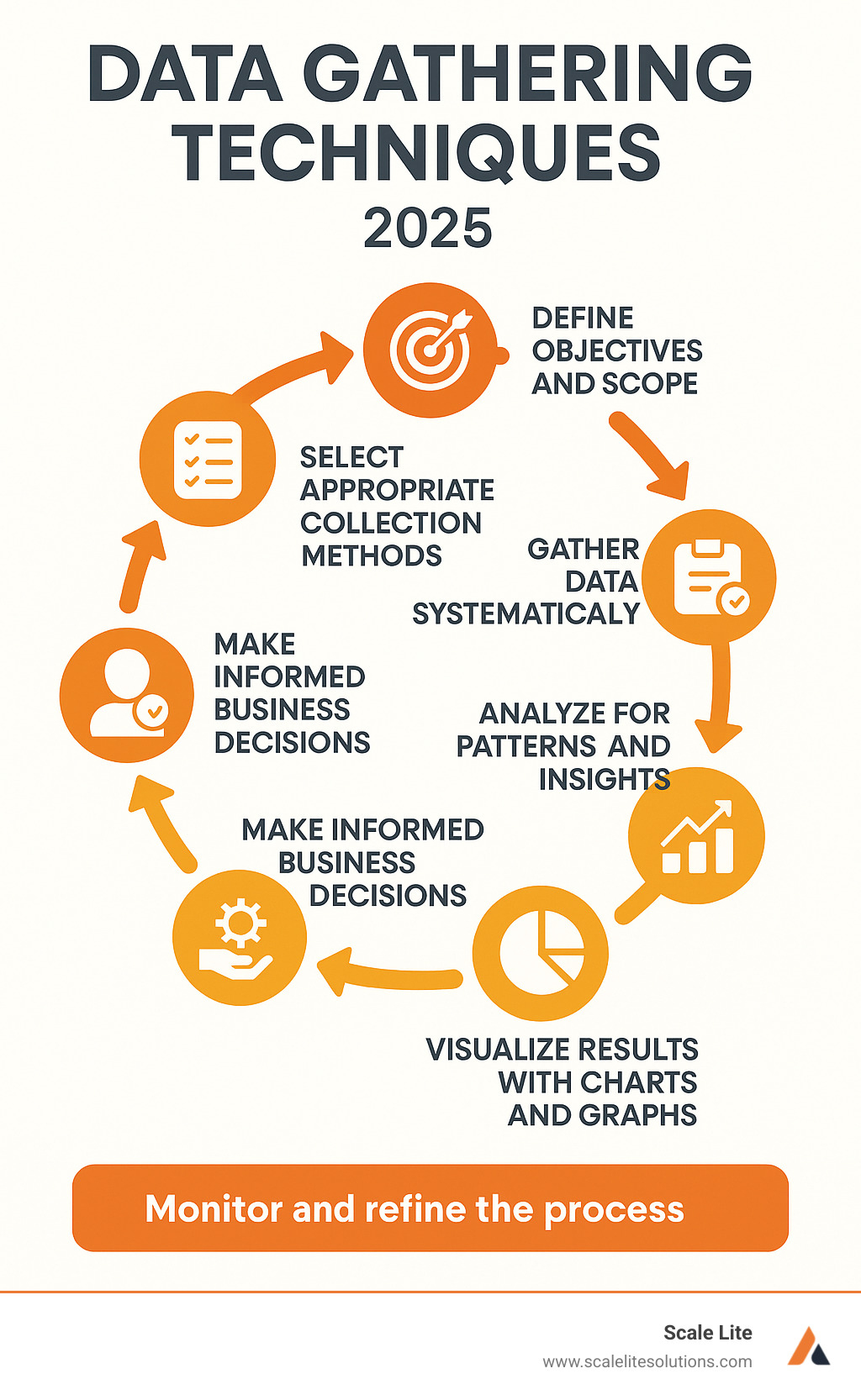
Gather 'Round: Essential Data Collection Methods for Businesses

Why Every Business Owner Needs to Master Data Collection
Data gathering techniques are the systematic methods businesses use to collect, measure, and analyze information that drives smarter decisions. With data volume predicted to reach 181 zettabytes by 2025, according to Statista, knowing how to collect the right information is essential for survival and growth.
Effective data collection involves understanding different methods (like interviews, surveys, and online tracking) and data types (qualitative vs. quantitative, primary vs. secondary). Most successful businesses use a mix of these. For example, a restaurant might survey customers about satisfaction (quantitative), interview loyal patrons about their experience (qualitative), and track online ordering patterns to get a complete picture.
The bottom line is that good data gathering isn't about collecting everything—it's about collecting the right information to make better decisions faster. The right strategy can transform how you understand and grow your company.

Relevant articles related to Data gathering techniques:
Why Data Collection is Your Business's Superpower
Without solid data, every business decision is a guess. Data gathering techniques are your secret weapon, changing hope into a clear strategy for results. It's the difference between wondering if a marketing campaign worked and knowing exactly which channels brought in qualified leads.
Good data collection provides the precision and accuracy to stop wasting money on ineffective strategies. It enables informed decision-making, helps maintain quality assurance by spotting problems early, and gives you a competitive edge by allowing you to pivot faster than rivals. Most importantly, it helps you truly understand customers—their needs, preferences, and pain points—so you can build genuine connections.
This foundation of smart data collection is what drives data-driven decision making and helps businesses achieve true operational excellence.
Qualitative vs. Quantitative: Understanding Your Options
Data comes in two main flavors: qualitative and quantitative. Both are essential, but they tell you different things.
Qualitative data is descriptive and answers "why." It captures opinions, feelings, and motivations through methods like interviews and open-ended survey questions. When a customer explains why they chose a competitor, that's qualitative gold. As noted in a research guide from Macalester College, this data helps solve complex problems where the solution isn't obvious.
Quantitative data is numerical and answers "how many" or "how much." This includes statistics, measurements, and anything you can count, like service calls per month or customer satisfaction scores. It comes from multiple-choice surveys, tracking systems, and analytics.
The magic happens when you use both. Quantitative data might show that 40% of customers cancel, but qualitative data will tell you they're frustrated with your scheduling system.
Primary vs. Secondary Data
Another key distinction is whether you collect data yourself or use existing information.
Primary data is information you collect directly for your current needs, such as through customer surveys or interviews. It’s custom-made for your questions and highly relevant, giving you full control over quality.
Secondary data is existing information from sources like industry reports, government statistics, or competitor analyses. It's often cost-effective and provides valuable context for broader market trends, helping you focus your primary research efforts.
A smart approach combines both: use secondary data to understand the landscape, then collect primary data to answer your specific business questions.
A Tour of 9 Essential Data Gathering Techniques

Choosing a data gathering technique is like picking the right tool for a job. The method must match your goal. If you want to know why customers love your service, you'll need a different approach than if you need to know how many service calls you handled last month.
Start by clarifying your objective. Are you trying to improve customer satisfaction, launch a new service, or understand employee turnover? Each question demands its own method. Also, consider your resources—some methods require more time and money than others.
Smart businesses often use a mix of methods to get the complete picture. Over the next sections, we'll walk through essential techniques that work well for service-based businesses, so you'll know which tool to reach for when you need answers.
1. Interviews and Focus Groups
To understand what makes your customers tick, you need to go beyond numbers. Interviews and focus groups are powerful data gathering techniques for revealing the stories and motivations behind customer behavior.
One-on-one interviews are deep dives where you ask open-ended questions to uncover emotions and frustrations. For example, a plumbing company might learn that customers value clear communication on arrival times just as much as fast service.
Focus groups bring six to twelve people together to discuss your business. The group dynamic often sparks new perspectives as participants build on each other's comments, revealing shared concerns that individual interviews might miss.
Strengths vs. Limitations: These methods provide rich, detailed qualitative insights that can uncover unknown problems. However, they are time-intensive, require skilled facilitators to avoid bias, and can be influenced by dominant personalities in a group setting.
2. Surveys and Forms
When you need to hear from a large audience without breaking the bank, surveys and forms are your go-to data gathering techniques. They are versatile tools for asking important questions at scale via email, websites, or social media.
Surveys can capture both quantitative data ("Rate our service on a scale of 1-5") and qualitative feedback ("What could we do better?"). This mix helps you measure performance and understand the story behind the numbers. For example, a simple survey might reveal that your biggest selling point is how clean your team leaves a job site.
Forms are perfect for capturing specific details during user interactions, like service registrations or newsletter sign-ups. They are highly effective for lead generation, gathering contact information while potential customers are actively engaged.
Strengths vs. Limitations: Surveys and forms are scalable, cost-effective, and can collect data 24/7. However, they often suffer from low response rates and potential "subject bias," where people give answers they think you want to hear. They also lack the conversational nuance of an interview.
3. Observation
Sometimes the best way to understand behavior is to watch it unfold. Observation is a data gathering technique that involves studying people or processes in their natural settings without direct interaction. It reveals what people do versus what they say they do.
Direct observation could involve watching how customers steer a store or how employees use a new software. As noted by researchers at Washington State University, this systematic watching and recording of behavior is the most common form of observation. Online observation involves tracking user paths on a website—where they click, how long they stay, and where they drop off.
Strengths vs. Limitations: Observation provides authentic, unfiltered data that highlights the gap between words and actions. It's excellent for understanding user experience and operational bottlenecks. However, the method can be subjective, as it relies on an observer's interpretation, and it doesn't explain the "why" behind behaviors. Ethical considerations around privacy and consent are also paramount.
4. Online and Transactional Tracking
Every click, scroll, and purchase tells a story. Online and transactional tracking are powerful data gathering techniques that offer a window into real-time customer behavior.
Website cookies track how visitors steer your site, creating a map of the customer journey that shows what's working. E-commerce purchase data reveals buying patterns, seasonal trends, and popular products. For instance, a restaurant might find that customers who order appetizers are more likely to leave positive reviews. Social media monitoring helps gauge brand sentiment by tracking mentions and engagement across platforms.
Strengths vs. Limitations: These methods provide automated, real-time behavioral data at scale, showing what customers actually do. However, this power comes with great responsibility. Privacy concerns are critical, and you must comply with regulations like GDPR and CCPA, obtain proper consent, and be transparent about how you use data to maintain customer trust.
5. Modern Digital Data Gathering Techniques
Digital technology has revolutionized data gathering techniques, enabling automated, real-time collection that was once impossible. Instead of manual entry, these systems work continuously in the background.
Here's a quick comparison:
| Feature | Traditional Data Collection | Modern Digital Data Gathering Techniques |
|---|---|---|
| Methods | Surveys, Interviews, Observations, Paper Forms, File Uploads | API-Based Ingestion, Change Data Capture (CDC), Event Streaming, Webhooks, Log Collection, IoT/Sensor Data |
| Automation | Often manual, labor-intensive | Highly automated, continuous |
| Latency | Batch processing, delays in data availability | Real-time or near real-time |
| Volume | Limited by manual capacity | Handles massive data volumes (Big Data) |
| Data Source | Human input, documents, static files | Databases, applications, devices, external systems, events |
| Accuracy | Prone to human error, inconsistencies | High accuracy, consistency through automation |
| Scalability | Difficult to scale | Designed for scale and rapid growth |
| Use Case | Opinion polling, qualitative research, historical analysis | Real-time analytics, operational monitoring, predictive modeling |
Key modern methods include:
- API-based ingestion: Allows your different software systems (like CRM and marketing platforms) to talk to each other automatically, eliminating manual data transfer.
- Change Data Capture (CDC): Acts like a security camera for your database, recording only what's new or different. This keeps all systems synchronized efficiently and in real-time.
- Event streaming: Captures a constant flow of activities, like website clicks or purchases, giving you an instant pulse on your operations.
These modern approaches mean less manual effort, higher accuracy, and real-time insights. They form the backbone of effective business automation platforms that transform business efficiency.
From Raw Data to Smart Decisions: The Analysis Process
Raw data is like a pile of puzzle pieces—useless until you start connecting them. No matter how good your data gathering techniques are, the information is just digital clutter without analysis. The analysis process transforms scattered data points into clear, actionable insights that guide smart business decisions.
Key Steps in Data Analysis
Getting from raw data to smart decisions follows a clear path:
- Establish a Goal: Define the specific question you need to answer to provide clear direction.
- Plan Data Collection: Choose the right data gathering techniques based on your goal.
- Collect Data: Execute your plan, focusing on accuracy and quality.
- Clean Data: This critical step involves fixing errors, removing duplicates, and standardizing formats to ensure reliability.
- Evaluate Data Quality: Assess if the collected data is complete and unbiased enough to answer your question.
- Analyze Data: Apply analytical techniques to uncover trends, correlations, and patterns.
- Visualize Data: Use charts and graphs to make complex findings easy to understand.
- Interpret and Act on Insights: Translate your findings into specific, actionable strategies for your business.
This process creates a streamlined path from questions to answers, supporting better business process streamlining and driving smarter decisions.
Overcoming Common Problems and Ethical Considerations

Even the best data gathering techniques face challenges. But just as important as overcoming problems is doing things the right way. Ethical data collection isn't just about legal compliance—it's about building trust with your customers.
Common Challenges in Data Collection
Businesses often face predictable issues. Poor data quality can lead to flawed decisions (garbage in, garbage out). Volume overwhelm makes it hard to find the right data in a sea of information. Integration issues arise when data is siloed in different systems, and high costs or internal skill gaps can hinder progress. These challenges can be overcome with standardization, smart automation, and scalable systems.
Ethical Information Gathering
With the power of data comes great responsibility. Ethical data handling is non-negotiable for sustainable growth.
- Informed Consent: Be transparent about what data you're collecting and why. No fine print or tricks.
- Participant Privacy: Safeguard personal information from unauthorized access or misuse.
- Data Security: Use robust protocols like encryption and access controls to protect data.
- Anonymizing Data: Protect individual identities by removing personal identifiers where possible.
- Transparency: Write privacy policies that are clear and easy for anyone to understand.
- Legal Adherence: Comply with guidelines like GDPR and CCPA. The strict protocols used by organizations like the World Anti-Doping Agency show how data can be handled with integrity.
Ethical practices build customer loyalty, which is good for your conscience and your bottom line.
Frequently Asked Questions about Data Gathering Techniques
What are the two main types of data gathering techniques?
The two main types are qualitative and quantitative. Qualitative data is descriptive (words, stories) and answers "why." It's gathered through interviews or open-ended questions. Quantitative data is numerical (stats, scores) and answers "how many." It's collected via surveys with ratings or analytics. The most successful businesses use both to get the full picture.
Why is accurate data collection so important for my business?
Accurate data collection is the foundation for smart business decisions. It ensures you're acting on reality, not guesswork. It helps you truly understand customers, improve operational efficiency by fixing the right problems, and drive profitable growth by focusing resources on what works. Inaccurate data is misleading and leads to costly mistakes.
How do I choose the right data collection method?
Choosing the right method depends on your goals, budget, and timeline. Start with your goal: what question are you trying to answer? For deep feedback, use interviews. To measure satisfaction across a large group, use a survey. To see how users interact with your website, use online tracking. The best approach often combines methods to identify a problem, quantify its scope, and then understand the reasons behind it.
Conclusion: Put Your Data to Work
We've covered the landscape of data gathering techniques, from interviews and surveys to modern digital tracking. We've seen how to transform raw numbers into smart decisions and steer the common challenges and ethical duties that come with data collection.
The key takeaway is this: data is one of your most valuable assets. The businesses that thrive today are those that systematically collect, clean, analyze, and act on their data. They understand their customers better, spot problems earlier, and make decisions based on facts, not hunches.
But gathering data is only half the battle. The magic happens when you put that information to work to improve your service, plan for the future, and eliminate bottlenecks.
At Scale Lite Solutions, we help service businesses and companies in traditional industries implement the right technology and processes for effective data gathering. Our approach isn't just about collecting more data; it's about collecting the right data and using it to drive real improvements in how you operate, serve customers, and grow your business.
Ready to turn your data into your competitive advantage? Learn how AI and Automation can transform your business and find what's possible with the right systems in place.






